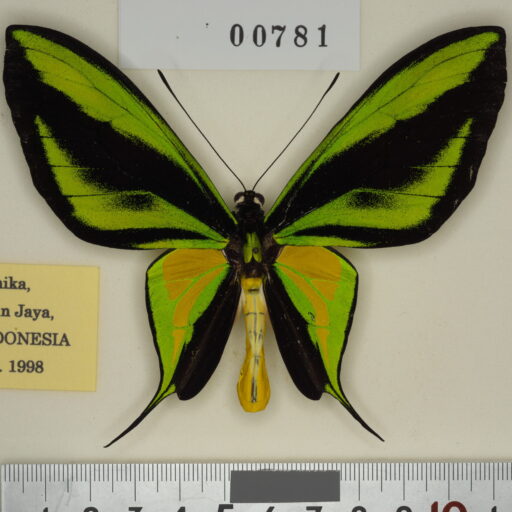For entomologists, writing an insect encyclopedia is a lifelong dream. I never thought that one day I would be able to publish a “complete encyclopedia” of the world’s largest and most beautiful butterflies, the Birdwings, as online content, which would be impossible with paper media due to limited space and high costs. This “Digital Encyclopedia Birdwing Butterflies” is a collection of specimens owned by Dr. Takashi Ohya (a heart surgeon and ornithopterist), author of “Birdwing Butterflies” (1983, Kodansha), and photographed by me, Dr. Yukio Yasui, a professor at the Laboratory of Entomology, Faculty of Agriculture, Kagawa University, Japan. The contents of this digital encyclopedia cover 34 species of birdwing butterflies, including 12 Ornithoptera, 2 Trogonoptera, and 20 Troides (in addition some natural hybrids), all of which are huge and beautiful. Here, the dorsal and ventral surfaces of all 3,286 specimens in the Ohya collection are perfectly reproduced in high-resolution photographs. Some of these specimens were also used in “Natural History of Birdwing Butterflies” by Hirotaka Matsuka (2001, Matsuka Shuppan) and Visual Encyclopedia “World Insect DATA BOOK” (1) Birdwing Butterflies (2005, De Agostini). These specimens have never been on display and are kept in a cool, dark room with controlled temperature and humidity, so their innate beauty and freshness are remarkably well preserved. The coloring of the photographs is standardized to a gray standard and recorded with nearly the same coloring as the specimens themselves, and furthermore, the photographs are reproduced with such high resolution that each and every scale can be clearly seen when magnified at 100%. Specimens were photographed 61 times over a period of 5 years and 4 months, from 2017 to 2022, with a steady accumulation of about 55 specimens each time, or 110 dorsal and ventral shots. During these years, the Corona disaster threatened the continuation of the project, but my determination to complete it did not waver.
In preparing this digital encyclopedia, all specimens were serially tagged, specimen data was entered into a computer file, a distribution map based on the current reported habitat of each genus, species, and subspecies was created and digitized, and explanatory text was included in both Japanese and English. “Episodes of discovery and original description” have been added for representative subspecies to provide enjoyable reading for the general reader who is not an expert entomologist. Furthermore, the reprinting here of Dr Ohya’s extremely marvelous work, Ohya (2008) “Original Descriptions of Birdwing Butterflies” (1) Genus Ornithoptera, (2) Genus Trogonoptera, Genus Troides, and a supplement (2012)(caution, HUGE PDF files), which he compiled to commemorate the 250th anniversary of the first description of the species (Linnaeus, 1758), has further enhanced the material value of this digital encyclopedia (Readers can read the original descriptions of all species, subspecies, local forms, aberrations, etc. described in the 254 years since Linnaeus, totaling 694 taxa, in the original language and Japanese translation). Another advantage of the online encyclopedia is the ability to see the ventral surface of all individuals, which is almost impossible to see in a booklet. It is not only that so many individuals are displayed. In the limited space of paper media, there is no choice but to select representative individuals, but here we can see the continuous variation of spots by displaying all individuals (for example, the female variation of O. priamus poseidon after 00294 is remarkable). The specimens themselves will be donated to the University of Tokyo’s Museum in the future, but we are proud to be able to release them here as digital content from Yasui laboratory in advance of that. There is no need to explain how to navigate the site. Just click on the various links and explore the world of Birdwing butterflies. Yasui’s recommendations are added for those individuals (e.g., this one) that are worthy of special mention as a butterfly lover and evolutionary biologist. It would be interesting to find them. It would be my greatest pleasure if you could enjoy it to your heart’s content.
Finally, I would like to express my deepest gratitude to Mr. Takeru Yamakawa, a graduate student in the Yasui Laboratory, Faculty of Agriculture, Kagawa University, who has made a great contribution to the creation of this website. Without his cooperation, this Digital Encyclopedia would not become a reality. Mr. Takanori Doi, an information technician of Kagawa University gave us great technical helps. I deeply appreciate his effort.
25 December 2024
Professor Yukio Yasui, Ph.D. (Agricultural Science)
Evolutionary Biologist
Laboratory of Entomology, Faculty of Agriculture, Kagawa University, Japan
Contact me: yasui.yukio(at)kagawa-u.ac.jp : Please replace ‘(at)’ with ‘@’.
ORCID: 0000-0003-4875-9836
Yukio Yasui – Google Scholar
https://researchmap.jp/read0195371?lang=en
The content on this website is permitted for free viewing, but commercial use is prohibited. When quoting content, please ensure proper citation. If you would like to purchase the original photographs, please contact us using the inquiry form. All text and photographs are copyrighted by Takashi Ohya and Yukio Yasui. All maps are copyrighted by Google.
Cite this Digital Encyclopedia as
Ohya, Takashi and Yasui, Yukio (2025, Feb., 16). “Digital Encyclopedia Birdwing Butterflies”. Products of Yasui Laboratory, Faculty of Agriculture, Kagawa University.
https://doi.org/10.57372/0002000671
In order to take advantage of the immediacy of online publication and to reflect the most current and accurate information, the content of this website is revised from time to time. Each revision will update the cited date. We do not change information retrospectively. We have presented a new approach to online publishing of academic information.





